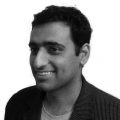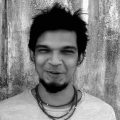
Ahmedabad is a city of opportunity; a city that accepts, adopts and adapts. It is a city that is inviting of new ventures and new imagination. It has heritage that provides richness of life, patrons that support education, art and culture and it has a strong sense of ‘community’ that comes by the convivial nature of the citizens. But Ahmedabad is also a city of contradictions. The rapidly stretching urban fabric has resulted in increasing demands for infrastructure and a direct brunt of this haphazard development is faced by the public spaces. In a race to become a ‘mega city’, the inherent character of the city, which was defined by its public spaces is lost. The chowks, the bazaars, the streets and the playgrounds are replaced by dull, monotonous, sterile, vacant areas that do not allow for life to thrive.
The Indian situation demands a response that is slightly varied from the general global response. The present day context and our shared interface of reality relies heavily on technology. The forms and formats around us have been developed via the influence of technology but it does not mean that all systems are actually conditioned by technology. Here, in India, technology has not permeated more than ten percent of our collective lives. So, in order to address the entirety of the spectrum of sensibilities out there, we have to adopt a set of new methodologies.
We want to punctuate the IAAC Global Brief with a few more things. One is the question of human sensibilities mapped onto a parameter that can be defined through some method. The other is modeling thought in terms of a system that comprises of parameters which can be compiled in different ways. Hence, the attempt is to create urban element with interactive, playful and utilitarian applications that rip apart the layer of apathy that our public places are shrouded in.
The Global Summer School: Ahmedabad Node, aims to explore computational design methodology based on data driven strategies to manifest in a tangible and interactive urban element that is a resultant of overlaying optimized design strategies, environmental data and advanced manufacturing techniques. Students will learn to design and build a responsive, interactive dynamic urban element that allows for play and exploration and changes expressions based on the different times of the day and night. This element is nebulous and evolves using data energies from the public and the city’s vibrant riverfront, collected through sensors. The workshop will include design and making with data visualization, robotics, working with hardware and programming arduino/sensors, augmented/virtual reality and digital fabrication integrated into computational design workflow to construct an interactive feature that activates the city’s riverfront.
The format of the workshop is team based participation leading to individuals acquiring design and execution skills, systems thinking and a detailed understanding of physical computing and interactive design thinking. The process will involve mapping of human behavior and sensibilities through Arduino prototyping platform and different kind of electronic devices as sensors and actuators. While developing Iot (internet of things) platforms, data collected through these sensors and other existing resources like social media and open source database platforms, will be actuated into a tangible interactive installation. The structure of the program consists of seminars, discourse groups and workshop that include material research, development of complex geometrical 3D form, fabrication details and techniques, developing small scale prototypes and finally the fabrication of a 1:1 urban machining intervention on site; transferring and digitally interrelating multiple sets of data collected from hyper-connected cities.
IAAC Global Summer School is a full-time two-week course that provides both practical and theoretical knowledge. Its structure consists in three main learning modules, led by expert tutors. In addition, lectures by renowned professionals and academics relevant to the topics to be treated during the course. These will be broadcasted in the different node-cities, all globally connected. The lecture program will be announced prior to GSS commencement. During GSS17-AHM, Core relevant concepts of Humanities and Philosophy will be imbibed along with internalization of Computational Architecture (theory and methods), Code (rational and practical understanding) and Landscape Analysis (methodology to investigate various superimposed layers of information of any space).

Bhanu Pratap Sharma is the principal architect at Office of Design & Development. After completing his graduation in Architecture from CEPT University, Ahmedabad and post-graduation in Urban Design from the University of Toronto, Canada, Bhanu has gained experience in the fields of architecture, conservation, urban design, industrial design, and scenography. ODD grows on a trajectory built by Bhanu’s decade of academic experience, which orients him to build an intensive research oriented practice. A maker at heart, Bhanu likes to be referred to as an “Artist – Engineer”. The multitude of physical and digital models strewn about in the refurbished studio at 124, Ambli bears testimony to this. As department head, he spearheaded a revamping of the curriculum, infusing it with a multi-disciplinary spirit by collaborating with architectural firms and design institutes across the globe in order to adapt a lateral approach into the symbiotic relationships that materials, spaces and details share.

Chirag is an architect. After Studying architecture at CEPT University, Ahmedabad, India, His interests in investigating the relationship between architecture, society and media led him to pursue a Masters at IAAC (Institute for Advanced architecture of Catalonia), Barcelona, Spain where he developed interdisciplinary skills of territorial, architectural and algorithmic design operations through computational design tools and emergent technologies. Further he excelled in digital tools and advanced manufacturing technologies by graduating Fab Academy (Course by MIT’s Center for Bits and Atoms). Since 2014, He is a partner at Noumena. Parallel to that He is a coordinator at RESHAPE – digital craft community, and leading the project NERO | Networking Environmental Robotics; a collaborative project with aim to develop systems and robots to translate different environmental conditions into data. He has also been tutor at IAAC and Fab Academy.

Sahil Ahuja is a programmer with experience ranging from building mission critical banking applications to fabricating scalable dev-ops solutions for high traffic websites. Ever since his first brush with coding in high-school he has been a hacker at heart.
He started his career in Goldman Sachs developing real time trade processing applications. He then did a post graduation in management from Indian Institute of Management – Calcutta in 2010-12 and worked as a currency trader in Bank of America. In 2015 he tried his hand at building a sports news publication company SportsCafe as Co-Founder from ground up. He founded GMETRI in Jan-2017 to extend the digital world to the physical world with VR, 3D technologies and Machine Learning. He is also known to be a free software advocate, photographer and a chess player.

Artist, Architect, Computational Designer and Entrepreneur. A practicing Architect and Engineer with over a decade of experience, he is currently researching and combining fields such as Computational art, design, Fabrication, Vedic Science, Artificial Intelligence, Machine learning and Synthetic Biology. Shridhar is also working on a couple of books. Being a designer with a wide variety of skillsets and knowledge he has gained over years is translating ideas into products across various disciplines, also own his own Furniture and Jewellery brand (upcoming). He persists to emerge as one of the top computational designers globally.

Utsav Mathur earned his Masters in Advanced Architecture from the Institute of Advanced Architecture of Catalonia, Barcelona, where he focused on Computational Design, Robotics, Digital Fabrication, Augmented and Virtual Reality among other technologies.His pioneering research on shell structures has been referenced globally, and he constructs thin shell concrete structures with his patented technology and in-house execution team at Infinity&Beyond Building Solutions, which was founded by him in 2013, after graduating from NIT Trichy. He has built two such structures in India, and is currently working on his first brick form-active shell. He founded GMETRI in 2017 as his venture into bringing technologies like Virtual and Augmented reality, among others, to the masses in an accessible format.

Abhinav is an architect, interaction designer and new media artist. His practice lies at the intersection of art, craft, science, technology and design. He has done several projects that use physical computing with tangible / hybrid interfaces and interactive art installations. Through his work he likes to examine the relationships between technology, spaces and culture in the dynamic Indian cultural fabric. His recent design projects include low cost prefab bamboo shelters in Arunachal Pradesh, a visual programming language for an educational robotics kit and a much anticipated video game rooted in an alternate south Indian past. His loves the transdisciplinary nature of his work and likes to function in situations where lack of definition persists and new grounds need to be defined informed through practice and research.
IAAC GSS is open to creative and innovative people who are interested in fields such as architecture, urban planning, digital fabrication, design, etc., searching for a multidisciplinary experience in an international environment. No previous skills are required, although CAD design, programming and digital fabrication skills are welcome. The official language of the course is English. Each participant should bring his/her own computer with the software installed. Further details about the software will be given to the participants upon acceptance.
After the course, the participants will have gained theoretical and applicative knowledge about current urban innovative strategies. Moreover, they will become familiar with parametric software, data visualization and the use of digital machines. In the end of the course all participants will receive a Global Summer School Diploma from IAAC.
Each participant is responsible to investigate what documents are required via the embassies in their country of origin. The school will provide a confirmation letter regarding the participation in the course, and will assist where possible in the visa process.
The early registration fee is 550 € for Ahmedabad node until 5th May 2017. The fee includes all the expenses for material, electronic hardware and sensors, all CNC machinery tools for fabrication needed for the course. No additional registration fee is required. Flight tickets, accommodation and food are not included in the fee.
The GSS17 Ahmedabad program is co-orgnaised by D3LAB and Indus University (Gujarat) at Institute of Design Environment and Architecture (IDEA), Rancharda, Via: Thaltej, Ahmedabad – 382 115, Gujarat, INDIA.
In order to register to the Global Summer School, participants need to submit the online application form, where they will be asked to upload a letter of intent and a CV. Portfolio is not required. The applications are open until the 30th of May 2017.